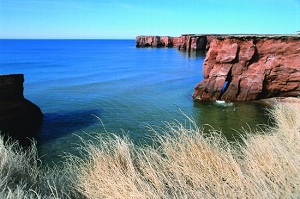 Tall, athletic and very, very, fit, Gaston led the way across the top of the cliffs striding through the high dune grasses and climbing nearly perpendicular sand hills. I struggled to keep up with him and used the need to take more photos as an excuse to slow him down. The sea had eroded the red cliffs creating dramatic archways and huge red pillars, ideal perches for the gulls and cormorants who were sunning themselves and drying their wings. It was a bright sunny day and with the blue sky, green sea, distant islands, sand dunes and shoals in the background — my excuse was highly believable.
Tall, athletic and very, very, fit, Gaston led the way across the top of the cliffs striding through the high dune grasses and climbing nearly perpendicular sand hills. I struggled to keep up with him and used the need to take more photos as an excuse to slow him down. The sea had eroded the red cliffs creating dramatic archways and huge red pillars, ideal perches for the gulls and cormorants who were sunning themselves and drying their wings. It was a bright sunny day and with the blue sky, green sea, distant islands, sand dunes and shoals in the background — my excuse was highly believable.
Despite the fact that this scenic beauty required little interpretation, Gaston Arseneau and I were having difficulty communicating. His English was limited and my French was learned too many years ago for it to be very effective. Even so, I would still have had problems, Les Îles de la Madeleine are a relatively unknown group of islands in Québec and have been isolated over the centuries. Their language has evolved over generations from a unique mix of English, French and Scottish shipwreck victims, native Micmac hunters, French and British colonists and, most notably, Acadians escaping deportation.
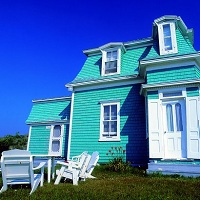
- © Le Québec maritime / George Fischer
The islands lie in the heart of the Gulf of St. Lawrence encircled by Nova Scotia and Prince Edward Island to the south, New Brunswick and Québec’s Gaspé Peninsula to the west, Québec to the north and Newfoundland to the east. The archipelago comprises a dozen islands of which six are inhabited and connected to one another by long, thin, sand dunes in the shape of a half moon stretching across a distance of 65 km, and one main road, with the somewhat incongruous title of Highway 199. Secondary paved roads encircle each of the islands and rejoin the highway.
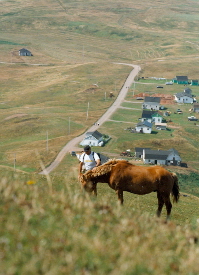 Gaston and I were hiking across Île d’Entrée the only inhabited island not linked by land, and a one hour boat trip by Excursions en Mer, Gaston’s company, which operates out of Cap aux Meules. Much closer to hand, a long narrow sand spit reaches out from Île du Havre Aubert seeking to connect— and in the winter it does. Freezing waters and snow combine to create an ice bridge allowing the local people to travel across in horse-drawn sleds. There is a wonderful story about a work horse named “Farmer” that in 1923 was sold to a man who lived at the far end of the archipelago. The ice bridge was used to facilitate the sale and Farmer traveled to his new home, a total distance of 100 km. But the horse didn’t like his new master and early in the summer he disappeared. One afternoon residents of Île d’Entrée were amazed to see him swimming across the 2 mile wide channel from the sand spit. Despite the distance and the treacherous currents he made it home, and was allowed to remain on the island for the rest of his life.
Gaston and I were hiking across Île d’Entrée the only inhabited island not linked by land, and a one hour boat trip by Excursions en Mer, Gaston’s company, which operates out of Cap aux Meules. Much closer to hand, a long narrow sand spit reaches out from Île du Havre Aubert seeking to connect— and in the winter it does. Freezing waters and snow combine to create an ice bridge allowing the local people to travel across in horse-drawn sleds. There is a wonderful story about a work horse named “Farmer” that in 1923 was sold to a man who lived at the far end of the archipelago. The ice bridge was used to facilitate the sale and Farmer traveled to his new home, a total distance of 100 km. But the horse didn’t like his new master and early in the summer he disappeared. One afternoon residents of Île d’Entrée were amazed to see him swimming across the 2 mile wide channel from the sand spit. Despite the distance and the treacherous currents he made it home, and was allowed to remain on the island for the rest of his life.
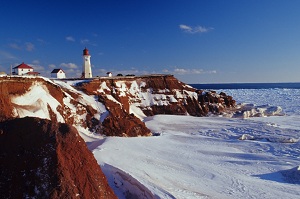
- Credit: D.I.Jeske Islands: Havre-Aubert
One day, the sand spit will extend to create a permanent link with the six other inhabited islands. The dunes are the result of coastal erosion. Waves crash against the red cliffs and the sea carries the sand to the shallow waters and deposits it on these beaches. For now though, the island provides a true opportunity to get away from it all. In spring and fall it can be a wildlife paradise with a wide variety of birds, puffins, seals and small penguins on their migratory routes. 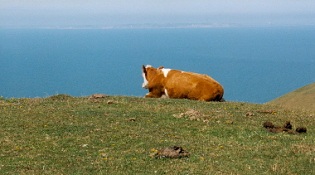 Île d’Entrée is also the island with the highest hill— 174 meters above sea level — and an unequaled view of the archipelago. After an exhausting climb up Big Hill, I stood triumphant and looked at the beautiful undulating hills around me. Horses showing no sign of exertion were wandering up and down the steep grade of the hill while cows sat on top contentedly chewing the grass and looking out to sea. A light mist blanketed the other islands. Somehow it enhanced my feeling of having escaped from the pressures of city life.
Île d’Entrée is also the island with the highest hill— 174 meters above sea level — and an unequaled view of the archipelago. After an exhausting climb up Big Hill, I stood triumphant and looked at the beautiful undulating hills around me. Horses showing no sign of exertion were wandering up and down the steep grade of the hill while cows sat on top contentedly chewing the grass and looking out to sea. A light mist blanketed the other islands. Somehow it enhanced my feeling of having escaped from the pressures of city life.
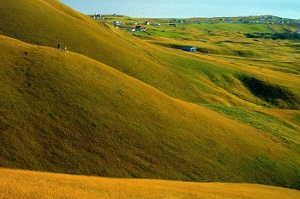
© Le Québec maritime / George Fischer
Back down the hill we walked over to the few houses that make up the community and I chatted with a couple of the residents. Île d’Entrée has one of two Anglophone communities in the archipelago and I was curious about their history. Strangely they don’t know and don’t seem to have much interest. “We never bother much with that” said one elderly gentleman “I know my father was born here and his father before him and they might have had something to do with the shipwreck of The Miracle in 1847.” 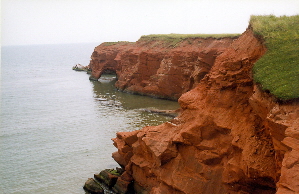 It is highly probable. The reefs and shoals of the islands rank them as the second largest graveyard of the Atlantic after SableIsland. One of the most tragic shipwrecks was that of TheMiracle. She was used to transport emigrants who were escaping from the great famine in Ireland and hoping to start a new life in Canada.
It is highly probable. The reefs and shoals of the islands rank them as the second largest graveyard of the Atlantic after SableIsland. One of the most tragic shipwrecks was that of TheMiracle. She was used to transport emigrants who were escaping from the great famine in Ireland and hoping to start a new life in Canada. 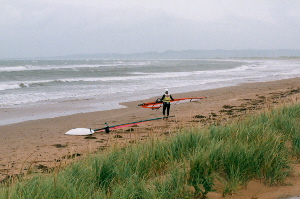 The ship had no amenities and in her crowded, unsanitary condition, many people died from typhus. So many in fact that she and many other ships were sent to quarantine before their passengers were allowed to step ashore in Québec. On May 19, 1847 she never made it across the Gulf: of the 446 passengers, close to 150 lost their lives in the terrible shipwreck. The islanders worked hard to save lives, but by bringing the victims ashore many contacted typhus themselves. Most of the survivors eventually traveled on to other parts of Canada. Orphaned children, however, were adopted by families on the islands.
The ship had no amenities and in her crowded, unsanitary condition, many people died from typhus. So many in fact that she and many other ships were sent to quarantine before their passengers were allowed to step ashore in Québec. On May 19, 1847 she never made it across the Gulf: of the 446 passengers, close to 150 lost their lives in the terrible shipwreck. The islanders worked hard to save lives, but by bringing the victims ashore many contacted typhus themselves. Most of the survivors eventually traveled on to other parts of Canada. Orphaned children, however, were adopted by families on the islands.
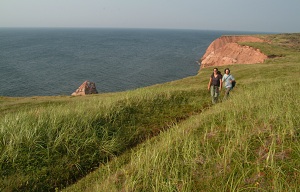
Credit: G.Thériault
Another resident, Brian Josey, though equally uninformed about his family history prior to World War 2, proved to be a budding entrepreneur. “I started a small restaurant here” he told me “Now I do bed and breakfast. I’m also interested in renting out some of the property to people interested in developing their own business.” It’s an intriguing idea. It would be a great location for a spa. And artists and writers could truly develop their talents and let their creativity run free. 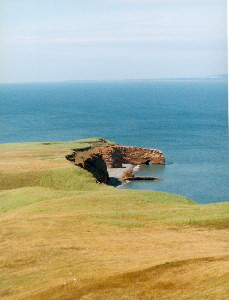 So, if you are looking for a real escape, back to nature with no television or telephone, lots of hiking and good fresh sea air, nature at its most pristine, stunning scenery, and honest, but very few people — why not try a week on Île d’Entrée. I have a suspicion that after a few days on this island you’ll forget about work and might even rediscover the meaning of life. And if you can’t handle the isolation, you can always take the boat back to Cap-aux-Meules and explore the other six inhabited islands. For more information visit www.tourismeilesdelamadeleine.com and also check out the items listed in the travel tips that accompany the episode information for our three video features (1) Culture and cuisine (2) The seal excursion and (3) Adventures with wind and water.
So, if you are looking for a real escape, back to nature with no television or telephone, lots of hiking and good fresh sea air, nature at its most pristine, stunning scenery, and honest, but very few people — why not try a week on Île d’Entrée. I have a suspicion that after a few days on this island you’ll forget about work and might even rediscover the meaning of life. And if you can’t handle the isolation, you can always take the boat back to Cap-aux-Meules and explore the other six inhabited islands. For more information visit www.tourismeilesdelamadeleine.com and also check out the items listed in the travel tips that accompany the episode information for our three video features (1) Culture and cuisine (2) The seal excursion and (3) Adventures with wind and water.


